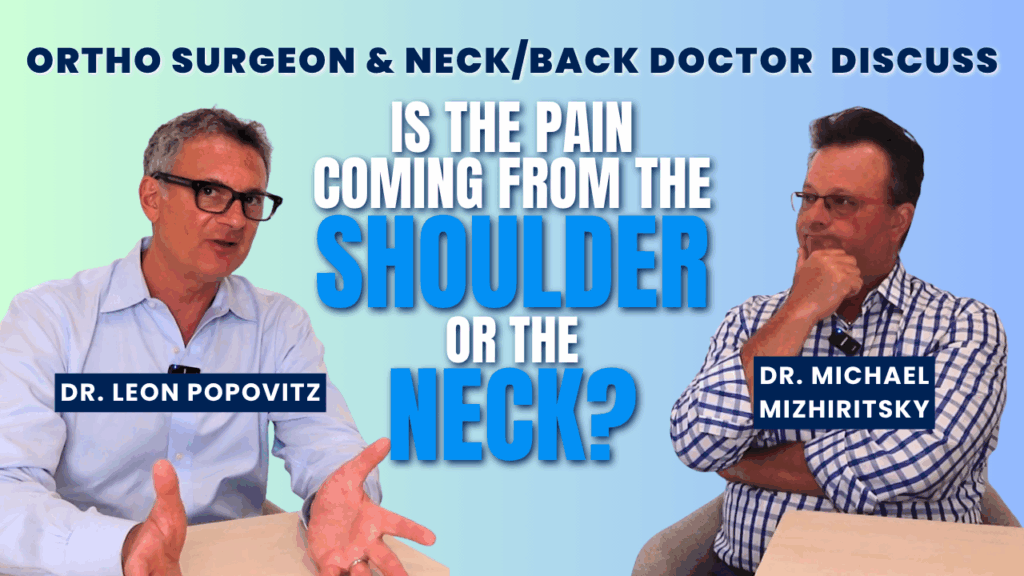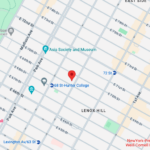Shoulder pain is one of the most common complaints we hear in orthopedic practices, but did you know that the source of the pain may not always be the shoulder itself? In this blog, Dr. Leon Popovitz and Dr. Michael Mizhiritsky from NY Bone & Joint Specialists break down the relationship between shoulder and neck pain, and how to distinguish between the two.
Understanding the Overlap Between Neck and Shoulder Pain
Dr. Popovitz and Dr. Mizhiritsky emphasize a crucial point: Shoulder pain can sometimes actually originate from the neck. While the shoulder is an obvious source of discomfort, many patients don’t realize that their symptoms may be referred pain coming from their cervical spine (neck). This is where the expertise of both a shoulder surgeon and a spine specialist becomes essential.
“Is It the Shoulder or the Neck?”
Dr. Popovitz shares that when patients point to their shoulder but indicate pain up higher in the upper back or neck, it’s a clue that the issue may not be in the shoulder joint itself. According to Dr. Mizhiritsky, muscular issues around the neck and upper back, such as tightness in the trapezius muscles, can refer pain to the shoulder area. “This isn’t always a shoulder pathology problem,” says Dr. Mizhiritsky, and a thorough examination is needed to pinpoint the exact cause.
How to Identify the Source of Pain
When a patient comes in with shoulder pain, the first thing both doctors do is take a detailed history. Questions such as: “Did you sleep wrong?”, “Do you have any numbness?”, or “Did you experience any trauma like a fall?” are key in determining the cause. Nerve involvement, especially when tingling or numbness is present, can point to a pinched nerve in the neck or even a herniated disc.
Dr. Popovitz adds, “Even though I’m a shoulder specialist, if the pain is referred from the neck, it’s important to assess for nerve involvement right away.”
When Tingling and Numbness Are Present
Tingling and numbness are signs that a nerve may be compressed or irritated, often due to a herniated disc or cervical spine issues. Dr. Mizhiritsky explains, “If the pain in the shoulder is accompanied by these sensations running down the arm or into the fingers, we need to be concerned about nerve involvement.”
In these cases, MRI scans or nerve conduction tests help to identify the root cause, ensuring that the right treatment approach is taken. While physical therapy is often enough for nerve-related shoulder pain, more aggressive treatments, such as epidural injections, may be necessary if the condition worsens.
What If There’s Weakness?
Both experts agree that weakness is a significant concern. When a patient has shoulder weakness along with numbness or tingling, it could indicate nerve compression or damage. Nerve compression can lead to severe weakness and, if untreated, irreversible damage to the affected muscles. This is why early diagnosis and intervention are crucial.
Dr. Mizhiritsky stresses, “If you notice weakness in your arm or shoulder along with these symptoms, it’s important to get evaluated immediately to avoid permanent nerve damage.”
What About Shoulder Injuries?
Shoulder injuries, such as rotator cuff tears, are another common cause of pain in this area. Dr. Popovitz notes that shoulder pain often arises from overuse or trauma, like falling on an outstretched arm or lifting heavy weights. In cases of gradual, degenerative pain, spurs on the shoulder bone can scrape against the rotator cuff tendon, leading to rotator cuff injuries.
If a patient has persistent shoulder pain without a history of trauma, biceps tendonitis could be another possibility, particularly in older individuals. But if trauma is involved, rotator cuff tears are high on the list of potential diagnoses.
Posterior Shoulder Pain: What Could It Be?
When pain is felt at the back of the shoulder, it’s often a sign of a deeper issue like a labral tear. The labrum is a ring of cartilage that helps stabilize the shoulder joint. Overhead athletes, weightlifters, and those involved in repetitive shoulder motions are particularly susceptible to labral tears.
Dr. Popovitz explains, “A labral tear often develops gradually, particularly in younger athletes or individuals who are lifting weights or doing repetitive overhead activities. This pain can be insidious, building up over time.”
Clicking or popping sensations inside the shoulder can also be a sign of a labral tear, which occurs when the cartilage in the joint starts to fray and tear.
Treatment Options for Labral Tears
For younger patients with a traumatic labral tear, Dr. Popovitz recommends conservative treatments like physical therapy and scapular strengthening to improve posture and muscle support. However, if conservative treatments don’t relieve symptoms after a couple of months, surgical intervention may be necessary.
Dr. Popovitz shares, “For older patients with degenerative labral tears, non-surgical treatment often works well, but if the shoulder is unstable or pain persists, surgery may be required.”
Labral repair surgery has a high success rate, and patients typically recover well with proper rehabilitation. After surgery, athletes, including professional ones, often return to their sport or activity after full recovery.
When Neck and Shoulder Pain Are Both Involved
As both Dr. Popovitz and Dr. Mizhiritsky agree, neck and shoulder pain often overlap, and in some cases, both areas can be involved. It’s crucial to distinguish between the two and perform a thorough evaluation to determine the appropriate treatment plan.
Dr. Mizhiritsky concludes, “Sometimes, it could be both—the neck and the shoulder. It’s about finding the root cause and treating it effectively.”
Final Thoughts
If you’re experiencing shoulder pain, it’s important to seek expert care to determine if the pain is originating from the shoulder, the neck, or both. Early diagnosis and proper treatment are essential in preventing long-term damage. Whether it’s a simple muscle strain or a more complex issue like a labral tear or nerve compression, NY Bone & Joint Specialists are here to help.
If you’re dealing with shoulder or neck pain, schedule an appointment with our team today and take the first step toward recovery.
About NY Bone & Joint Specialists
At NY Bone & Joint Specialists, we specialize in diagnosing and treating musculoskeletal issues, from shoulder pain to spinal conditions. Led by Dr. Leon Popovitz and Dr. Michael Mizhiritsky, our team is dedicated to providing personalized, expert care to help you live pain-free.




